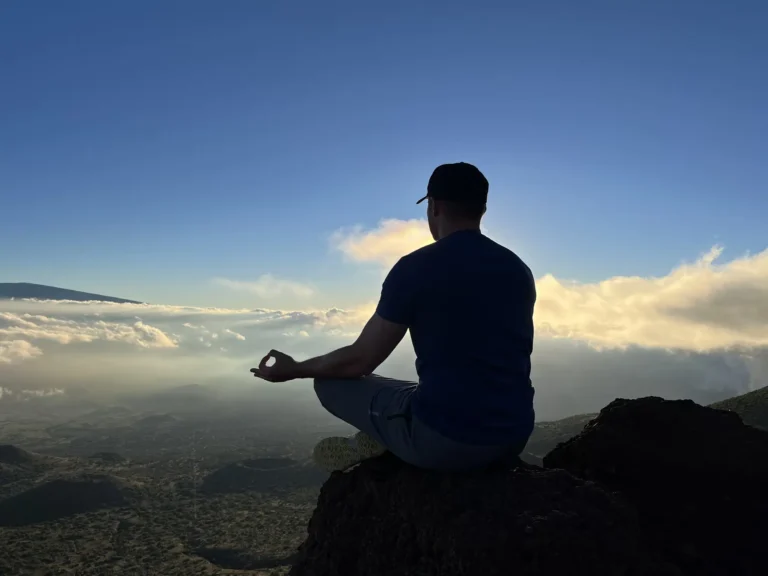
Do you ever feel like a stranger to yourself? Pulled in countless directions by external demands, expectations, and the endless scroll of digital life, it’s easy to lose touch with our own inner landscape. We might expertly navigate friendships, romantic partnerships, and professional connections, yet neglect the most fundamental relationship of all – the one we have with ourselves. We look outward for validation, fulfillment, and direction, often feeling adrift, anxious, or vaguely dissatisfied, without realizing that the anchor we seek lies within.
For years, society hasn’t really taught us to prioritize this inner connection But psychologists and wisdom traditions alike emphasize its paramount importance.
The relationship you cultivate with yourself is the foundation upon which your entire life is builtIt profoundly influences your mental and emotional well-being, your resilience, your decision-making, and the health and quality of every other relationship you form.
This guide explores How to Build a Relationship With Yourself First, offering mindful steps and actionable practices to turn inward, foster self-understanding, acceptance, and compassion, and ultimately, come home to yourself.
Why Your Relationship With Yourself Matters Most

It might sound cliché, but the longest and most intimate relationship you will ever have is the one with yourself. Nurturing this connection isn’t a luxury; it’s essential for navigating life with authenticity and well-being. A healthy self-relationship acts as an inner compass and a source of strength.
- Impact on Well-being: Research consistently links a positive relationship with oneself – characterized by self-esteem, self-acceptance, and self-compassion – to stronger mental health, including reduced anxiety, depression, and stressWhen you know and accept yourself, you’re better equipped to handle life’s inevitable challenges with resilience.
- Foundation for External Relationships: How you treat yourself sets the tone for how you allow others to treat you and how you engage in relationships . A strong inner foundation allows for healthier interdependence, clear boundaries, and authentic connection, rather than dynamics rooted in neediness or insecurity.
- Clearer Decision-Making: Knowing your values, needs, and intuition allows you to make choices – big and small – that are truly aligned with who you are and what you want, leading to greater life satisfaction.
- Increased Authenticity & Fulfillment: Connecting with yourself allows you to live more authentically, pursuing passions and goals that genuinely resonate, rather than chasing external validation or societal expectations.
Investing time and energy in building a relationship with yourself isn’t selfish; it’s the groundwork for a more stable, fulfilling, and consciously created life.
Step 1: The Art of Self-Awareness – Learning to Listen Inward

The first step in building any relationship is getting to know the other person. When that person is you, it means cultivating self-awareness: the ability to turn your attention inward and observe your thoughts, feelings, bodily sensations, and behavioral patterns without immediate judgment. Mindfulness is the key practice here.
- Practice Mindful Observation: Regularly take moments throughout your day to simply notice: What am I thinking right now? What am I feeling emotionally? What sensations are present in my body? Approach this observation with gentle curiosity, like watching clouds pass in the sky,
- Identify Your Inner Dialogue: Become aware of how you talk to yourself. Is your inner voice predominantly critical, supportive, anxious, or neutral? Noticing the tone and content of your self-talk is crucial.
- Name Your Emotions: Instead of vague feelings like ‘bad’ or ‘stressed,’ try to identify specific emotions (sadness, anger, fear, joy, disappointment). Naming them can make them feel less overwhelming and easier to understand.
- Tune Into Body Signals: Your body often holds wisdom. Notice physical tension, fatigue, or feelings of lightness. What might these sensations be telling you about your needs or emotional state?
- Journaling for Insight: Dedicate time to writing down your thoughts and feelings. The act of articulating your inner experience can bring immense clarity and reveal patterns you weren’t consciously aware of.
Self-awareness isn’t about analyzing yourself into paralysis; it’s about developing a clear, compassionate understanding of your own inner landscape.
Step 2: Practicing Radical Self-Acceptance – Embracing Your Wholeness

Once you begin to notice your inner world more clearly, the next step is self-acceptance. This means acknowledging and embracing all parts of yourself – your strengths, your weaknesses, your successes, your mistakes, your ‘light’ and your ‘shadow’ – without harsh judgment or the constant need to ‘fix’ yourself. It’s closely related to the concept of Radical Acceptance, which involves accepting reality as it is, especially things outside your control, without fighting against it.
- Acknowledge Imperfection: Understand that making mistakes, having flaws, and experiencing difficult emotions are universal parts of the human experience. Striving for perfection is futile and damaging.
- Observe Without Judgment: When self-awareness reveals thoughts, feelings, or traits you don’t like, practice observing them without immediately labeling them as ‘bad’ or ‘wrong’. Simply acknowledge their presence: “Okay, I’m feeling envious right now,” or “I notice a tendency towards procrastination.”
- Let Go of Comparison: Consciously work on reducing comparison to others. Recognize that everyone has their own unique journey, strengths, and struggles. Focus on your own path and progress .
- Embrace Vulnerability: Accept that vulnerability isn’t weakness, but a part of authentic human connection. Allow yourself to feel and acknowledge difficult emotions rather than suppressing them.
- Focus on Strengths: While accepting weaknesses, also make a conscious effort to identify and appreciate your strengths, talents, and positive qualities .
Self-acceptance doesn’t mean giving up on growth; it means starting from a place of honesty and kindness towards who you are right now. You can’t build a healthy relationship with someone you’re constantly criticizing or trying to change – and that includes yourself.
Step 3: Cultivating Self-Compassion – Becoming Your Own Ally

Building directly on self-acceptance is self-compassion: actively treating yourself with kindness, care, and understanding, particularly when you are suffering, feeling inadequate, or have made a mistake. Think of it as turning the compassion you might readily offer a friend inward towards yourself. Dr. Kristin Neff identifies three key components:
- Self-Kindness: Being gentle and understanding with yourself rather than harshly critical. Offering yourself warmth and non-judgmental support during difficult times. Ask yourself: “What would I say to a dear friend in this situation?”
- Common Humanity: Recognizing that suffering, failure, and imperfection are part of the shared human condition. You are not alone in your struggles. This perspective combats feelings of isolation and shame.
- Mindfulness: Holding your painful thoughts and feelings in balanced awareness, without suppressing them but also without exaggerating them or getting lost in negative rumination .
Practices:
- Self-Compassion Break: When feeling stressed or inadequate, pause, acknowledge the pain (“This is a moment of suffering”), connect with common humanity (“Suffering is part of life”), and offer yourself kindness (place hand on heart, speak kind words internally.
- Compassionate Self-Talk: Intentionally reframe critical thoughts into supportive, understanding language.
- Forgiveness: Practice forgiving yourself for past mistakes, recognizing you did the best you could with the knowledge and resources you had at the time.
Self-compassion is the antidote to the harsh inner critic that often undermines our relationship with ourselves. It builds emotional resilience and creates a safe inner space.
Step 4: Showing Up For Yourself – Consistent Self-Care & Trust

A healthy relationship requires showing up consistently, offering care, and building trust. The same applies to your relationship with yourself. This means actively engaging in self-care and building self-trust.
- Actionable Self-Care: This goes beyond occasional treats; it’s about consistently tending to your fundamental needs:
- Physical: Prioritizing adequate sleep, nourishing food, and enjoyable movement.
- Emotional: Making space for feelings, engaging in activities that bring joy, seeking connection when needed, protecting your peace.
- Mental: Engaging your mind, learning new things, taking mental breaks, reducing overwhelm.
- Spiritual (if applicable): Connecting with your values, spending time in nature, meditation, or practices that foster a sense of meaning.
- Building Self-Trust: Trust in yourself grows when you act in alignment with your values and keep promises you make to yourself.
- Honor Your Boundaries: When you set a boundary (e.g., limiting work hours, saying no to a draining commitment) and stick to it, you teach yourself that your needs matter.
- Keep Small Promises: If you decide to journal for 5 minutes, or take a walk, or practice a hobby – follow through. Each small act of keeping your word to yourself builds inner reliability.
- Listen to Your Intuition: Pay attention to your gut feelings and inner wisdom. Start trusting these signals, even in small decisions, and observe the outcomes.
Showing up for yourself consistently demonstrates self-respect and builds the inner security needed to navigate life with greater confidence.
Step 5: Discovering & Honoring Your Authentic Self

Building a relationship with yourself also involves discovering and honoring who you truly are beneath societal conditioning and others’ expectations. This means connecting with your core values, passions, and needs.
- Identify Your Core Values: What principles are most important to you in life (e.g., honesty, creativity, connection, adventure, justice)? Journaling or using value-sorting exercises can help clarify these. Living in alignment with your values fosters authenticity.
- Explore Your Passions & Interests: What activities make you lose track of time? What subjects genuinely excite your curiosity? Make time for these, not because you ‘should,’ but because they nourish your unique spirit .
- Listen to Your ‘Yes’ and ‘No’: Pay attention to what activities, people, and environments energize you (your ‘yes’) and which drain you (your ‘no’). Use this awareness to make more aligned choices.
- Connect with Your Inner Child: Reflect on what brought you joy, curiosity, and excitement as a child, before societal pressures took hold. Are there aspects of that authentic self you can reintegrate into your adult life?
- Trust Your Intuition: Practice listening to that quiet inner knowing, your ‘gut feeling’. It often holds wisdom about what is truly right for you, beyond logic or external opinions.
Honoring your authentic self means making choices, big and small, that reflect who you genuinely are and what truly matters to you.
The Unplugged Self: Creating Space for Inner Connection

In our hyper-connected, always-on world, consciously creating unplugged space is essential for building a relationship with yourself. Constant external input – notifications, social media feeds, news updates – keeps our attention scattered and directed outward, making it difficult to hear our own inner voice.
- Embrace Solitude: Spending intentional time alone, without digital distractions, is not loneliness; it’s an opportunity for self-discovery, reflection, and recharging, Use this time for journaling, meditation, walking in nature, creative pursuits, or simply being still. It allows buried thoughts and feelings to surface.
- Digital Detox Periods: Experiment with designated tech-free times – perhaps evenings, one day a weekend, or even longer retreats. Notice how your awareness shifts when you’re not constantly reaching for a device.
- Mindful Tech Use: When you do use technology, be intentional. Are you using it consciously for connection or information, or mindlessly scrolling to avoid uncomfortable feelings? Curate your feeds to minimize comparison triggers.
- Prioritize Real-World Experiences: Engage fully in offline activities that nourish your senses and ground you in the present moment – cooking, gardening, playing music, spending time with loved ones face-to-face.
Disconnecting from external noise creates the quiet sanctuary needed to truly listen to, understand, and connect with yourself.
How to Build a Relationship With Yourself First: Nurturing the Bond

So, How to Build a Relationship With Yourself First? It’s an ongoing process, a commitment to treating yourself with the same curiosity, kindness, respect, and attention you would offer a cherished friend or partner. It involves the integrated practice of:
- Listening Inward: Through mindfulness and self-awareness.
- Embracing Wholeness: Through self-acceptance, including imperfections.
- Offering Kindness: Through self-compassion, especially in difficult times.
- Demonstrating Care: Through consistent self-care and honoring boundaries.
- Living Authentically: By discovering and aligning with your values and passions.
- Creating Space: Through intentional solitude and disconnecting from external noise.
This isn’t about achieving a perfect state of self-love, but about consistently choosing to turn towards yourself with curiosity and care. It’s a relationship that requires nurturing, attention, and commitment, just like any other important bond in your life.
Common Concerns & Solutions on the Self-Relationship Journey

Turning inward can feel unfamiliar or even uncomfortable initially. Here are some common concerns:
Concern 1: “Spending time alone feels lonely or boring.”
- Solution: Differentiate between chosen solitude (for reflection/recharging) and unwanted loneliness. Start with short periods of alone time focused on an enjoyable analog activity (reading, music, nature walk). Reframe ‘boredom’ as ‘spaciousness’ for thoughts and creativity to emerge. If persistent loneliness is an issue, balance solitude with seeking healthy social connection.
Concern 2: “It feels uncomfortable or scary to look at my thoughts and feelings.”
- Solution: This is normal! Be gentle and go slowly. Start with focusing on pleasant feelings or simple observations. Use mindfulness to observe difficult thoughts/feelings without judgment, like watching clouds. If deep-seated issues or trauma surface, seeking professional support from a therapist is crucial and courageous.
Concern 3: “Isn’t focusing so much on myself self-indulgent or selfish?”
- Solution: Quite the opposite. Understanding and caring for yourself enables you to be more present, resilient, and compassionate towards others. It fosters healthy interdependence rather than draining codependency. You cannot pour from an empty cup.
Concern 4: “I don’t even know where to start; it feels overwhelming.”
- Solution: Start incredibly small! Choose ONE practice from the checklist below that resonates most. Maybe just 5 minutes of mindful breathing or writing down one thing you appreciate about yourself each day. Consistency with small steps builds momentum.
Starting Your Self-Relationship Journey: Practical Tips

Ready to begin cultivating a deeper connection with yourself? Choose one or two simple actions to start:
- Schedule 5-10 Minutes of Quiet Time: Find a brief period each day for intentional solitude, free from devices and distractions.
- Practice Mindful Breathing: Dedicate 1-3 minutes to simply noticing your breath moving in and out.
- Start a Simple Journal: Write one sentence about how you feel, one thing you’re grateful for, or one observation from your day. Use prompts if helpful.
- Identify One Positive Quality: Acknowledge one thing you genuinely like or appreciate about yourself today.
- Notice Your Inner Critic: Simply become aware when negative self-talk arises, without judgment.
- Perform One Small Act of Self-Care: Drink a glass of water mindfully, stretch for 2 minutes, listen to a favorite song with full attention.
- Practice One Kind Reframe: Catch a self-critical thought and consciously rephrase it with more compassion.
- Limit One Comparison Trigger: Be mindful of one specific social media account or situation that often makes you feel inadequate, and reduce exposure.
Read more: How to Transform Your Self-Love Journey with Journaling
Come Home to Yourself

In the constant outward focus of modern life, we can easily become disconnected from our own inner compass, our own source of wisdom and validation. Building a relationship with yourself first is the journey of returning home – of learning to listen to, accept, trust, and care for the person you spend every moment with. It’s the most fundamental act of well-being, creating an inner sanctuary of peace and resilience that radiates outward into every other aspect of your life.
You now have a deeper understanding of why this relationship matters and actionable steps grounded in self-awareness, acceptance, compassion, care, and authenticity. You know that creating unplugged space is vital and that this journey requires patience and kindness above all else. It’s not about achieving perfection, but about consistently choosing to show up for yourself.
What is one small way you can connect with yourself today? Perhaps a few mindful breaths, a moment of self-compassion, or five minutes of journaling. Begin there. The most important relationship of your life is waiting for your attention. Come home to yourself; you are worthy of the journey.




